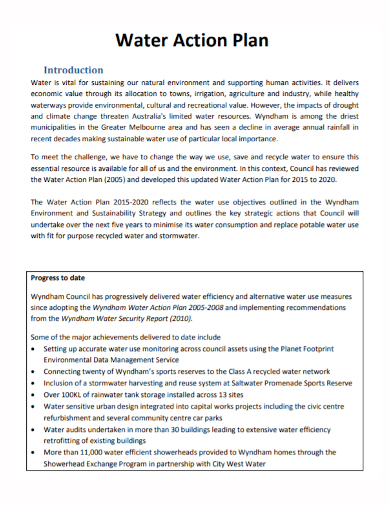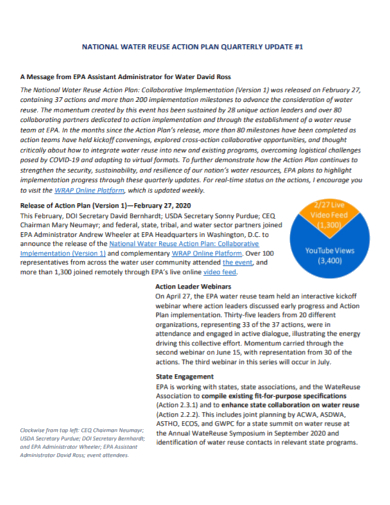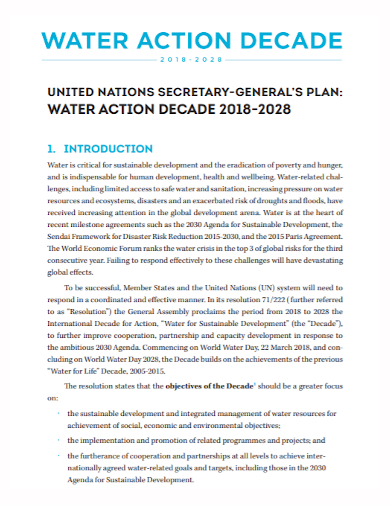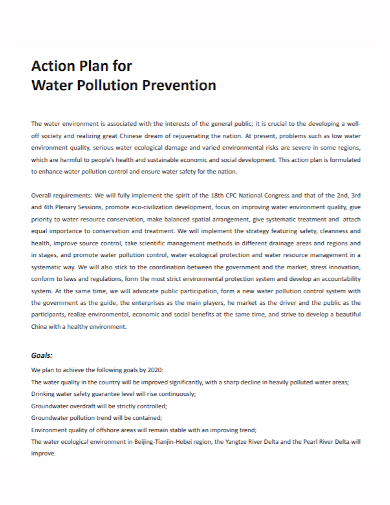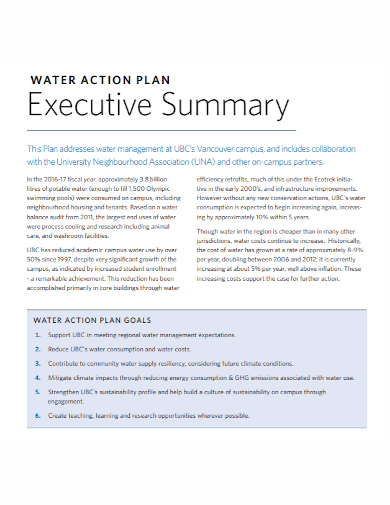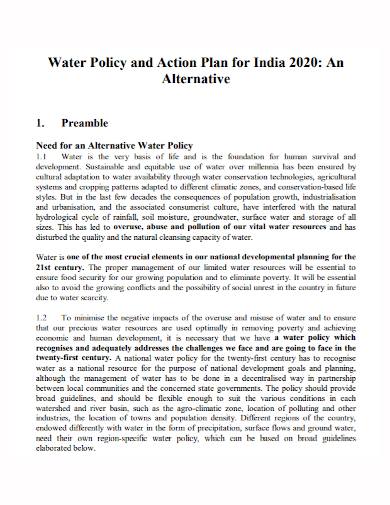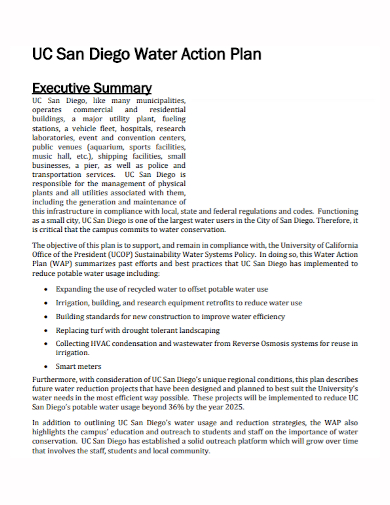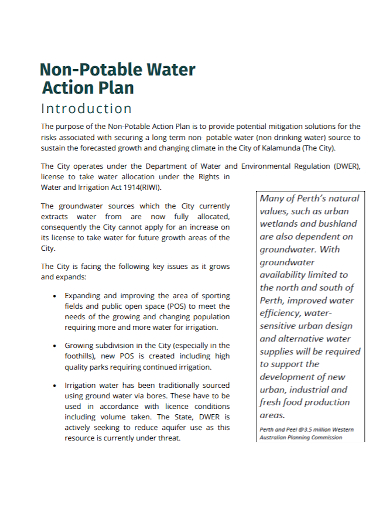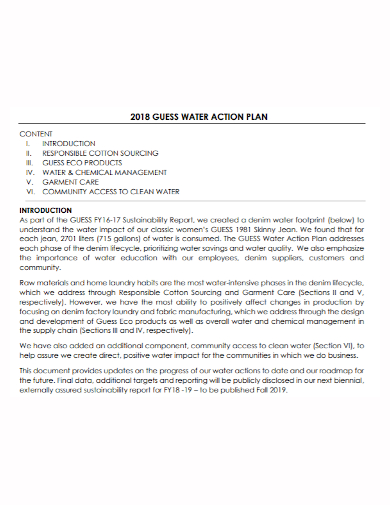10+ Water Action Plan Samples
Whether it is utilized for drinking, home usage, food production, or leisure, safe and readily available water is critical for public health. Improved water supply and sanitation, as well as improved management of water resources, may help countries thrive economically and reduce poverty. As such, implementing a solid plan in order to ensure the success of water systems, pollution reduction, and the like. Need some help with this? You’ve come to the right place! In this article, we provide you with free and ready-made samples of Water Action Plans in PDF and DOC formats that you could use for your organization. Keep on reading to find out more!
1. Water Action Plan Template
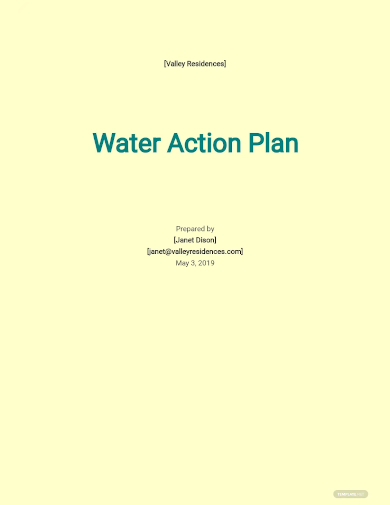
2. Water Action Plan
3. Water Refuse Quarterly Action Plan
4. Church Water Emergency Action Plan
5. General Water Action Plan
6. Water Pollution Action Plan
7. Water Action Plan Goals
8. Water Policy Action Plan
9. Sample Water Action Plan
10. Non-Potable Water Action Plan
11. Guess Water Action Plan
What Is a Water Action Plan?
Action plans are a type of communication tool that represents a significant reduction in the complexity of complicated programs and initiatives, such as fixing water contamination. A water action plan can help you map out strategies and small steps toward long-term water objectives. It assists you in determining what objectives you want to reach, when you want to achieve them, and what you need to do to get there. This allows you to concentrate your efforts on the tasks at hand.
How to Make a Water Action Plan
Individuals utilize action plans to design a strategy to attain their own personal goals, not just in project management. A Water Action Plan Template can help provide you with the framework you need to ensure that you have a well-prepared and robust action plan on hand. To do so, you can choose one of our excellent templates listed above. If you want to write it yourself, follow these steps below to guide you:
1. Define your primary goal.
You are setting yourself up for failure if you are unclear about what you want to do and achieve. Analyze the problem and consider all alternative remedies before deciding which are the most important. Then write out your goals. Also, before moving on to the next phase, make sure your goals meets the SMART criteria.
2. Make a list of tasks to prioritize and set a respective timeline.
It’s time to restructure the list by putting chores in order of importance. Some stages may need to be prioritized because they are obstructing other sub-processes. Make a list of deadlines and make sure they’re reasonable. Before setting deadlines, talk to the person in charge of carrying it out to get a sense of their capabilities.
3. Set Goals and Objectives.
Milestones are sub-goals that lead up to the ultimate objective. As you create milestones, start with the final aim and move backwards. Adding milestones has the advantage of giving team members something to look forward to, which helps them stay motivated.
4. Visualize your strategy.
The goal of this phase is to build something that everyone can grasp at a glance and share with others. Make sure your action plan properly conveys the aspects we’ve identified so far — tasks, task owners, deadlines, resources, and so on – whether it’s in the form of a flowchart, Gantt chart, or table.
FAQ
What exactly is a water management strategy?
The practice of planning, producing, distributing, and managing the most efficient use of water resources is known as water resource management.
What are the three planning levels?
Operational, tactical, and strategic planning are the three primary categories of planning.
What factors influence water quality?
Precipitation, climate, soil type, vegetation, geology, flow conditions, ground water, and human activities all have an impact on water quality.
Having access to clean water and sanitation eliminates the risk of contracting a variety of ailments. With both plans in place, your company can transform its strategy from a two-dimensional blueprint to a quantifiable action plan. To help you get started, download our easily customizable and comprehensive samples of Water Action Plans today!
Related Posts
FREE 10+ Quarterly Action Plan Samples
FREE 10+ Compliance Action Plan Samples
FREE 46+ Sample Action Plan
FREE 38+ Action Plan Templates
FREE 10+ Incident Response Plan Samples
FREE 10+ Sustainability Action Plan Samples
FREE 10+ Inventory Action Plan Samples
FREE 10+ Team Action Plan Samples
FREE 10+ Climate Action Plan Samples
FREE 10+ Research Action Plan Samples
FREE 10+ Quality Management Strategy Samples
FREE 10+ Environmental Action Plan Samples
FREE 8+ Mutual Action Plan Samples
FREE 5+ Housekeeping Action Plan Samples
FREE 10+ Emergency Action Plan Samples

